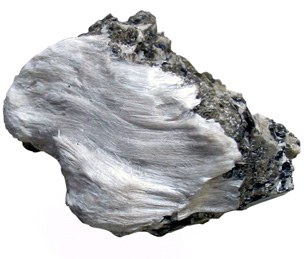Asbestos
| EPA Maximum Contaminant Level (MCL) |
7 million fibers per Liter (MFL) |

Natural asbestos fibers on muscovite.
Asbestos has never been a major concern in water treatment. “Asbestos” is actually a general term used to describe six separate fibrous materials. All have separable long fibers that are strong and flexible.
Asbestos forms the basis of more than 3,000 separate products. For example, brake pads, roofing and cement pipe for water distribution. It has been a popular product since the 1800s because of its strength and resistance to heat. It is very absorbent and has great tensile strength.
Asbestos exists in natural sources, but the main exposure to humans is from the breakdown of manufactured products. Use of asbestos cement for water pipes has been the main contributor of asbestos to water supplies.
Health Effects of Asbestos in Water
Asbestos is primarily a health concern when inhaled, rather than ingested through water.
Health risks of ingestion, according to the EPA:
Some people who drink water containing asbestos well in excess of the maximum contaminant level [7 million fibers per Liter] for many years may have an increased risk of developing benign intestinal polyps.
Water Treatment for Asbestos
The EPA recommends the following treatments for removing asbestos from water:
- Coagulation/filtration
- Direct and Diatomite Filtration
- Corrosion Control
Reverse osmosis is the preferred method for asbestos treatment at point of use.
Source: EPA, World Health Organization, Photo: WikiMedia, author: Aram Dulyan
Site Index
Filtration Systems
- Aeration for Iron & Sulfide
- Backwashing Filters
(whole house & well units)
- Chlorine & Chemical Injectors
- Countertop Water Filters
- Garden Hose Filters
- Reverse Osmosis, Residential
- Reverse Osmosis, Commercial
- Shower Filters
- Specialty Filters
- Ultraviolet Systems
- Undersink Filters
- Water Softeners
- Whole House Filters
Cartridges
Parts
- Replacement Parts
- Faucets
- Filter Media
- Fittings
- Housings
- O-rings
- Pumps
- Pura UV
- R.O. Parts
- R.O. Tanks
- R.O. Booster Pump
- VIQUA UV